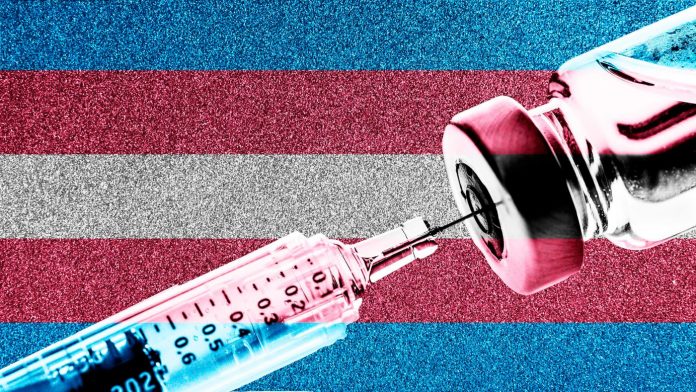The creator of the trans flag forced his wife to participate in his fetishistic cross-dressing and wrote ‘forced feminization’ and erotic short stories, including one about young girls who never age.
Monica Helms, born Robert Hogge, designed the first trans pride flag in 1999. In his memoir, More Than Just a Flag, Helms – who named himself after a fictional battle in Tolkien’s The Lord of the Rings – describes himself as an “enlightened” being who is able to “float” between multiple worlds.
“I identify as female, but I’m more of a bigender person,” Helms says. “This allows my brain to float between multiple worlds, or solidly take on one role or another. Sometimes I am a man and a woman at the same time, or I can change in a nanosecond, then change back just as fast.”
When narrating his childhood in the memoir, Helms details how, at the age of 12, he would steal his mother’s undergarments.
“I went into my parents’ bedroom and looked through my mother’s dresser drawers,” Helms writes, “I found several of my mother’s cotton panties and bras, nearly stacked in piles. The ‘Girl in the Shadows’ wanted to try them on. I wanted to try them on. When I did, they felt exciting to wear.”
This would become a secret ritual throughout his teen years, even as he began to take an interest in girls at school. “I would spend hours looking at the girls at school. I studied them more and more, with my study slowly evolving into lust,” Helms adds.
Helms spent his early adulthood “obsessed” with “losing [his] virginity” and experimenting with cross-dressing.
“My need to appear as a woman didn’t replace my need to have sexual relationships with women,” Helms attests, while explaining in great detail his sexual proclivities and relationships with women.
While serving with the US Navy during the 1970s, Helms began stealing women’s underwear from the laundry room of his apartment complex in South Carolina after seeing a woman’s bra inside one of the machines.
“Images of the days when I tried on my mother’s underwear came back to me, pulling primordial feelings with them… the obsession of losing my virginity had filled my every waking moment… Up until this point, my sexual desire for a first encounter had pushed every other fantasy of mine onto the back burner. As I stood watching the bra swirl around in the dryer, I sensed a growing desire to dress as a woman and to see the hidden woman within me.”
Helms then describes stealing the bra by taking it out of the machine, and rushing back to his apartment to try it on and model it for himself in the mirror. He then expresses sexual arousal at the sight of himself in the garment.
“The feelings I had, dressed as a woman, ran the gamut of human emotions. Sexual excitement topped the list of what came over me while wearing woman’s clothes.”
While stationed in San Diego in 1978, Helms began attending drag clubs. One evening, after going home with one of the club’s performers, Helms takes an interest in his wardrobe, saying, “She pulled out a corset from her dresser and helped me put it on. It gave me a wonderful hourglass figure. When I looked at my image in the mirror, I couldn’t help but be turned on.”
It was at this moment, Helms says, that he became determined to continue his fetishistic cross-dressing on a more regular basis: “the Navy had made a man out of me. Now, I had to tear that down to rebuild myself in my own image… as a woman.”
It was at this time that Helms began dating the woman he would go on to marry, Donna, and she strongly disapproved of his fetish.
“Six months into the marriage, I found out just how Donna really felt about my cross-dressing. She came home one day and found me wearing a dress. She went ballistic and told me in no uncertain terms that I would never dress like that at home ever again.”
Throughout the course of their marriage, Helms continued to pursue his sexual fetish against his wife’s wishes, spending family finances on clothing, makeup, and hormones. He also invested in attending get-togethers, or “Holiday En Femme,” with other male cross-dressers, where lessons were provided on how to talk and walk “like a woman.”
“At 46, I had entered my second puberty and acted the part. I would experiment with styles of clothing that weren’t appropriate for my age. More than once, a supervisor would call me into their office for wearing dresses cut too short,” Helms says.
It was Helms, not his wife Donna, who would ultimately decide to end the marriage and leave his wife and children. “They didn’t want me to leave, which made me feel even worse. But I couldn’t continue hiding my doctor visits and medical costs, not to mention receiving hateful comments from Donna about my shaved legs and breast growth.”
Helms insists he told his wife about his secret rituals before proposing, though he admits that “later in life, Donna would deny that I ever told her about my cross-dressing.” The continued pursuit of his desires against his wife’s wishes would ultimately lead to a total breakdown in their relationship, and they began the divorce process in 1997.
After his divorce was finalized, he began frequenting Arizona’s sex clubs which “afforded patrons the chance to watch people have sex in windowed rooms.” Helms tells of how these clubs “enabled me to fulfill each and every fantasy I had concerning sex with men. This included orgies, hot tubs, you name it.”
But Helms goes on to write that once he had “gotten all that out of my system” he began to identify as a lesbian woman. He attended lesbian clubs “three to four times a week” from 1999 to 2000, “flirting” and participating in “sensual dancing”.
Helms has also authored short stories with sexual themes, including ‘forced feminization,’ wherein men are transformed into women as a humiliating punishment. One story in particular sexualizes a child, and Helms said the concept came to him in a dream.
Titled “A Woman Scorned” — published in the collection Tales from a Two-Gendered Mind — a man finds himself being stalked by a young girl who looks “no more than sixteen years-old” and whom he initially mistakes for a Girl Scout.
“The beautiful girl looked at me with her alluring eyes… She announced, ‘All I want is you! I want to marry you,'” wrote Helms.
The child reveals herself to be a witch who claims to be older than she appears; among her powers is the ability to age very slowly, causing her to look “far younger than her true age.” The man marries her and they have a daughter: “Our baby has her mother’s magical powers.”
Helms was 48 years old and a veteran of the US Navy when he designed the transgender pride flag in 1999. He has claimed the baby blue and pink pastel stripes came to him by way of “divine intervention,” but the color scheme is often seen repeated in other, more nefarious contexts.
According to researcher Dr. Sarah Goode, CEO of StopSO (Specialist Treatment Organisation for the Prevention of Sexual Offending), pedophiles who organize online have developed their own culture, language, and symbols. One common symbol used in pedophile forums incorporates the colors baby blue, pink and white. In her lecture, ‘Hidden Knowledge: What We Ought to Know About Pedophiles,’ Dr. Goode shows a slide of the image, and says, “The pink half represents ‘girl lovers’ and the blue half represents ‘boy lovers.'”
The color code system appears to predate the initial design of the transgender flag and can be traced back to at least as early as 1997, according to online pro-pedophile forums.
Areas in Europe that advertise child trafficking to pedophile sex tourists have used the color code: “blue curtains mean a boy child prostitute and pink curtains a girl.”
It is unclear whether Helms was aware of this correlation at the time, but when discussing the symbolism behind the trans flag in an interview in 2017, Helms stated that blue represented young boys and pink represented young girls.
In the two decades since its creation, the transgender pride flag has been embraced by transactivists, medical institutions, and governments alike. It has been flown at academic institutions, from universities to preschools. It has been featured in learning resources for children and incorporated into designs for children’s clothing. The pink, blue, and white stripes have been displayed by MI6, the secret intelligence service of the United Kingdom, as well as outside the UK’s embassy in Washington, DC. The US Smithsonian’s National Museum of American History acquired the original flag for their collection in 2014.
In 2021, Helms formally requested President Joe Biden fly the trans pride flag at all US embassies.
Reduxx is a newly-launched, independent source of pro-woman, pro-child safeguarding news and commentary. We’re able to continue our work exposing predators and reporting the truth thanks to the generous support of our readers.













